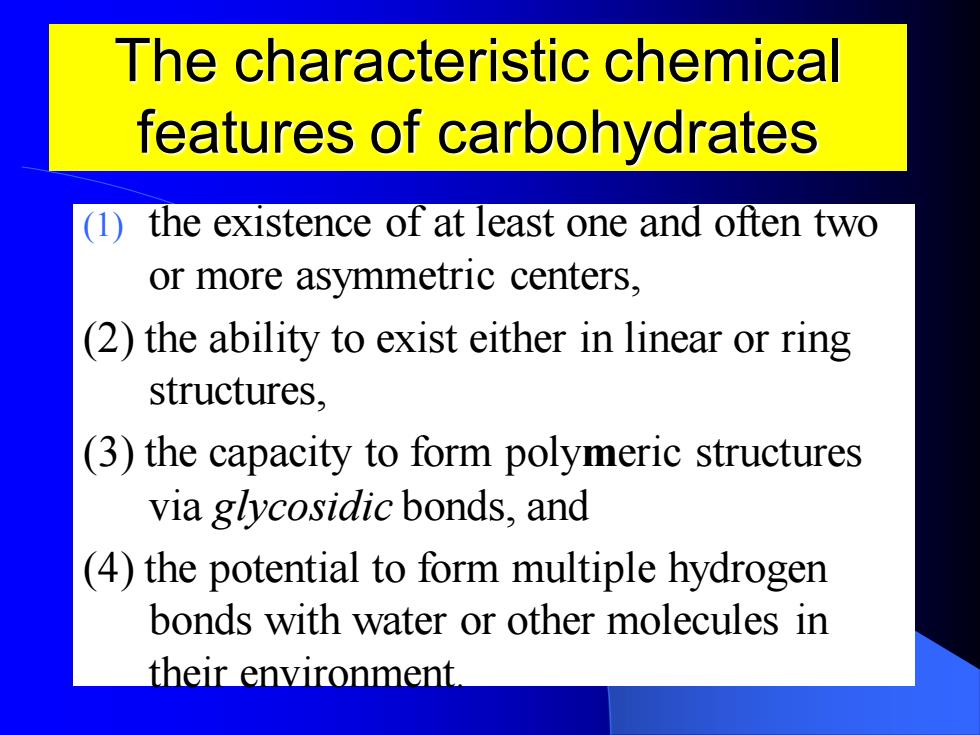
Chapter 4 Carbohydrates "The discovery of honey"-Piero de Cosm0(1462). Courtesy of the Worcester Art Museum)
Chapter 4 Carbohydrates "The discovery of honey"—Piero de Cosimo (1462). (Courtesy of the Worcester Art Museum)

Carbohydrates are the single most abundant class of organic molecules found in nature.The name carbohydrate arises from the basic molecular formula (CH2O)which can be rewritten (C.H2O) to show that these substances are hydrates of carbon,where n-3 or more
Carbohydrates are the single most abundant class of organic molecules found in nature. The name carbohydrate arises from the basic molecular formula (CH2O)n, which can be rewritten (C·H2O)n to show that these substances are hydrates of carbon, where n=3 or more

The functions of carbohydrates Energy molecules; Precursors of many other molecules; Structures (e.g.glycolipids); Recognition(e.g.glycoproteins)
The functions of carbohydrates Energy molecules; Precursors of many other molecules; Structures (e.g. glycolipids); Recognition(e.g. glycoproteins)

The characteristic chemical features of carbohydrates (1)the existence of at least one and often two or more asymmetric centers, (2)the ability to exist either in linear or ring structures, (3)the capacity to form polymeric structures via glycosidic bonds,and (4)the potential to form multiple hydrogen bonds with water or other molecules in their environment
The characteristic chemical features of carbohydrates (1) the existence of at least one and often two or more asymmetric centers, (2) the ability to exist either in linear or ring structures, (3) the capacity to form polymeric structures via glycosidic bonds, and (4) the potential to form multiple hydrogen bonds with water or other molecules in their environment

Carbohydrate Nomenclature Carbohydrates are generally classified into three groups: monosaccharides (and their derivatives). oligosaccharides, polysaccharides
Carbohydrate Nomenclature Carbohydrates are generally classified into three groups: monosaccharides (and their derivatives), oligosaccharides, polysaccharides

The monosaccharides are also called simple sugars and have the formula(CH2O) Monosaccharides cannot be broken down into smaller sugars under mild conditions
The monosaccharides are also called simple sugars and have the formula (CH2O)n . Monosaccharides cannot be broken down into smaller sugars under mild conditions

Oligo-saccharides derive their name from the Greek word oligo, meaning“few,”and consist of from two to ten simple sugar molecules. Disaccharides are common in nature,and trisaccharides also occur frequently
Oligo-saccharides derive their name from the Greek word oligo, meaning “few,” and consist of from two to ten simple sugar molecules. Disaccharides are common in nature, and trisaccharides also occur frequently

Four-to six-sugar-unit oligosaccharides are usually bound covalently to other molecules,including glycoproteins
Four- to six-sugar-unit oligosaccharides are usually bound covalently to other molecules, including glycoproteins

polysaccharides are polymers of the simple sugars and their derivatives. They may be either linear or branched polymers and may contain hundreds or even thousands of monosaccharide units.Their molecular weights range up to 1 million or more
polysaccharides are polymers of the simple sugars and their derivatives. They may be either linear or branched polymers and may contain hundreds or even thousands of monosaccharide units. Their molecular weights range up to 1 million or more

4.1 Monosaccharides Classification Monosaccharides consist typically of three to seven carbon atoms and are described either as aldoses or ketoses(suffix -ose means saccharide),depending on whether the molecule contains an aldehyde function or a ketone group
4.1 ·Monosaccharides Classification Monosaccharides consist typically of three to seven carbon atoms and are described either as aldoses or ketoses(suffix –ose means saccharide), depending on whether the molecule contains an aldehyde function or a ketone group